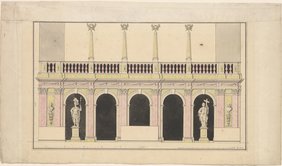The view of a rood screen architecture is very probably a design by the Münster military architect Lambert Friedrich Corfey (1668-1733) for Münster's St Paul's Cathedral. In 1990, the architectural historian Hans Josef Böker was able to prove that the design, together with another sheet from the collection, originally came from a series of drawings that had been compiled by Corfey himself or in his circle in a scrapbook. Further drawings from this are now in the Hanover City Archives.
The arrangement as a five-aisled open arcature between closed side panels corresponds to that of the late Gothic rood screen (built 1542-1549) in the cathedral, so that Corfey's proposal was probably intended as a remodelling. Böker suspects that the sheet, dated 1707, was intended as a presentation drawing with which Corfey wanted to recommend himself for future prince-bishop service on the occasion of the election of the bishop the year before. It remains unclear to what extent the two saintly figures depicted, which could be St Helena and St Gereon (or St Longinus), follow a programmatic concept.
Corfey was able to realise a few important projects during the time of his work, including the Dominican Church in Münster, which was constructed between 1708 and 1725. His report on the extended study trip that took him to France and Italy between 1698 and 1700 ( ARCHITRAVE project) is of great significance for research into architectural history. His projects, such as the Lettner design shown here, directly reflect buildings of the Italian Renaissance and the French Classicist Baroque, which Corfey had become acquainted with on the trip. Corfey thus proves to be a representative of a classicist movement around 1700 and an important mediator of these architectural forms in northwest Germany.
Simon Paulus

